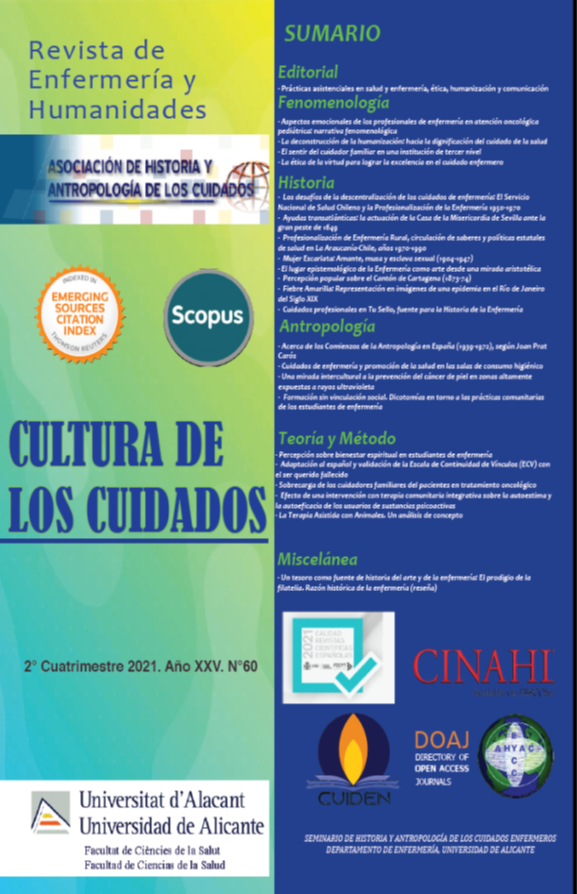La Terapia Asistida con Animales. Un análisis de concepto.
DOI:
https://doi.org/10.14198/cuid.2021.60.22Palabras clave:
Terapia asistida con animales, intervención asistida con animales, enfermedad mental, análisis de concepto, cuidados de enfermería de salud mental.Resumen
La literatura reporta sobre la "Terapia Asistida con Animales" beneficios para la salud en diferentes ámbitos y enfermedades.
Se pretende analizar el concepto de “Terapia Asistida con Animales” mediante la técnica de análisis de Wilson y proponer su uso en los cuidados enfermeros, en personas con enfermedad mental. Se identificaron los elementos conceptuales, revisión de la literatura y propuesta conceptual.
Este análisis favorece un uso más consistente del concepto y proporciona una visión más amplia del mismo. Ayuda a mejorar la práctica basada en la evidencia y a utilizar un lenguaje claro y conciso sobre el concepto, en las disciplinas interesadas en aplicar estas terapias.
Citas
American Veterinary Medical Association (2012). U.S. Pet Ownership & Demographics Sourcebook. Schaumburg, IL, USA.
Animal Assisted Intervention International (2013). General standards of practice for animal assisted activity, animal assisted education, animal assisted therapy and animal support. Available from: http://www.aai-int.org.
Asociación Madrileña de Veterinarios de Animales de Compañia (2017). Available from: http://www.amvac.es.
Benedito, M.C., Caballero, V. y López, J.A. (2017). Terapia asistida con perros en niños y adolescentes. Revista Española de Pediatría,73(2), 79–84.
Branson, S.M., Boss, L., Padhye, N.S., Gee, N.R. y Trötscher, T.T. (2019). Biopsychosocial Factors and Cognitive Function in Cat Ownership and Attachment in Community-dwelling Older Adults. Anthrozoös, 32(2), 267–82.
Cabra, C. (2012). Terapia asistida con animales. Efectos positivos en la salud humana. Journal of Agriculture and Animal Sciences,1(2), 32–45.
Cherniack, E.P. y Cherniack, A.R. (2014). The benefit of pets and animal-assisted therapy to the health of older individuals. Current Gerontology and Geriatrics Research, 2014, 623203.
Corson, S.A., Corson, E.O., Gwynne, P.H. y Arnold, L. (1977). Pet dogs as nonverbal communication links in hospital psychiatry. Comprehensive Psychiatry, 18(1), 61–72.
Corson, S.A., Corson, E.O., y Gwynne, P.H. (1975).Pet-facilitated psychotherapy. In Pet Animals and Society Anderson, RS, Ed; Baillière Tindall: London, UK.
Delta Society (1996). Standards of practice for animal-assisted activities and animal-assisted therapy. EEUU: Delta Society, editor.
Duran, V. (2018). Mascotas, un negocio que mueve 36.500 millones de euros al año en la Unión Europea. Expansión. Recuperado de : http: www.expansion.com
Fine, A.H., Beck, A.M. y Zenithson, N.G. (2019). The state of animal-assisted interventions: Addressing the contemporary issues that will shape the future. International Journal of Environmental Research and Public Health, 16(20),3997.
Fine, A.H. (2010). Handbook on Animal-Assisted Therapy: Theoretical Foundations and Guidelines for Practice. London: Academic Press.
Foreman, A.M., Glenn, M.K., Meade, B.J. y Wirth, O. (2017). Dogs in the workplace: A review of the benefits and potential challenges. International Journal of Environmental Research and Public Health,14(5), 498-519.
Gómez, M. (2019). Aulas multisensoriales en educación especial. España: Ed. Vigo.
Hall, S.S., Gee, N.R. y Mills, D.S. (2016). Children reading to dogs: A systematic review of the literature. PLoS One, 11(2):Article e0149759.
International Association of Human-Animal Interaction Organizations (2014).The IAHAIO definitions for animal assisted intervention and animal assisted activity and guidelines for wellness of animals involved. Available from: http://www.iahaio.org/new/fileuploads/ 4163IAHAIO white paper- final - nov 24-2014.pdf.
Levinson, B. (1969). Pet-Oriented Child Psychotherapy. Charles, C. Thomas: Springfield, IL, USA.
López-Cepero, J. (2019). Animales de compañía y salud. Del vínculo humano-animal al diseño de intervenciones asisidas por animales.Madrid: Ediciones Pirámide.
Jones, M.G., Rice, S.M. y Cotton, S.M. (2019). Incorporating animal-assisted therapy in mental health treatments for adolescents: A systematic review of canine assisted psychotherapy. PLoS One, 14(1), 1–27.
McCloskey, J. y Bulechek, G. (2005). Clasificación de Intervenciones de Enfermería (NIC). España: Elsevier España.
Nightingale, F. (1969). Notes on nursing: What it is, and what it is not. New York: Dover Publications, editor.
Pavlides, M. (2008). Animal-assisted Interventions for Individuals with Autism. London and Philadelphia: Jessica Kingsley Publishers.
Pet Partners. (2017). Pet Partner handler guide. Available from: http://petpartners.org.
Real Academia Española. Diccionario de la Lengua Española [Internet]. 23 ed. 2014. Available from: http://dle.rae.es.
Stefanini, M.C., Martino, A., Allori, P., Galeotti, F. y Tani, F. (2015). The use of Animal-Assisted Therapy in adolescents with acute mental disorders: A randomized controlled study. Complementary Therapies in Clinical Practice, 21(1), 42–6. Available from: http://dx.doi.org/10.1016/j.ctcp.2015.01.001.
Stefanini, M.C., Martino, A., Bacci, B. y Tani, F. (2016). The effect of animal-assisted therapy on emotional and behavioral symptoms in children and adolescents hospitalized for acute mental disorders. European Journal of Integrative Medicine, 8(2), 81–8. Available from: http://dx.doi.org/10.1016/j.eujim.2016.03.001.
Signes, M., Claverol, M. (2008). Animales de compañía y niños: una relación educativa terapéutica. Indivisa Boletín Estud e Investig [Internet]. 2008;9(1):117-44. Availablefrom:http://www.voraus.com/adiestramientocanino/modules/wfsection/html/a000604
Smith, B.P., Thompson, K.R., Clarkson, L. y Dawson, D. (2014). The prevalence and implications of human animal co-sleeping in an Australian sample. Anthrozoös, 27, 543–51.
Wilson, E.O. (1984). Biophilia. EEUU: Cambridge Harvard University Press.
Wilson, J. (1963). Thinking with concepts. EEUU: Cambridge Harvard University Press.
Descargas
Estadísticas
Publicado
Cómo citar
Número
Sección
Licencia
Derechos de autor 2021 judith jud balaguer sancho

Esta obra está bajo una licencia internacional Creative Commons Atribución 4.0.






